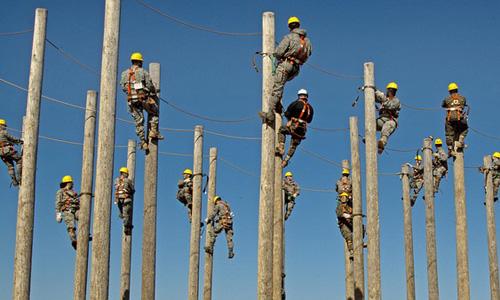Following multi-sector labor strikes, national protests for better wages and working conditions, the rise of both President Donald Trump and Senator Bernie Sanders and their focus on working people across the U.S., labor and jobs issues are finding their way back into the American conversation.
The decline of labor beat reporters in many newsrooms has required a new set of journalists to cover these issues. The beat is relevant to working- and middle-class Americans as it covers issues related to their livelihood.
It’s helpful to know the major players shaping messaging on labor and jobs, and how to localize and specialize that dialogue for readers.
Understanding the basics of organized labor
First, membership of organized labor has declined steadily since the 1950s. According to the most recent data published by the Department of Labor’s Bureau of Labor Statistics (BLS): In 2017, 10.7 percent (or 14.8 million workers) of the American workforce belonged to a union compared to nearly double that in 1983 (the first year BLS complied such data).
It’s also helpful to understand organized labor and its structure.
The AFL-CIO (American Federation of Labor – Congress of Industrial Organizations) is a major player in national politics representing organized labor. Many, but not all, unions in the United States belong to the AFL-CIO (some unions belong to the labor federation Change to Win). The AFL-CIO and Change to Win help organize lobbying and political activity and spending for its member unions.
State Federations and Central Labor Councils are statewide and local coalitions of unions and, along with community groups, coordinate state and local campaigning.
Local unions (locals) are the charter of national or international unions which organize workplaces based on employers, sectors or geographic regions. Locals also bargain with employers on behalf of members for a collective bargaining agreements (CBA) also known as the union contract.
Public- and private-sector union workers, right-to-work laws and Janus v. AFSCME
In 2017, 7.2 million employees in the public sector belonged to a union, compared with 7.6 million workers in the private sector, according to BLS. Union density in the private sector is significantly smaller than that of the public sector (6.5 percent unionization in the private sector compared to 34.4 percent in the public sector).
Most private-sector workers are “at-will” employees. Employers exercise the right to fire their employees for nearly any reason except those protected by law. Many public-sector workers have greater standards written into law. Most private-sector unions bargain for “just cause” termination, meaning the employer must have a “just cause” to fire an employee.
Right-to-work laws prohibit a union and employer from agreeing to require all employees to become dues-paying members of the union. More than half of the states in the U.S. have right-to-work laws on the books.
Agency fees, or fair-share fees, describe the process of unions charging nonmembers for services they provided through the bargaining process. In 2018, the Supreme Court ruled in Janus v. AFSCME that public-sector unions could not assess these fair-share fees to workers. This will likely impact future union density and bargaining power.
The Department of Labor’s Bureau of Labor Statistics
The U.S. Department of Labor’s Bureau of Labor Statistics (BLS) collects and reports on national data on employment, worker productivity, health and safety, pay and benefits and more.
The BLS releases unemployment numbers monthly, which generate national labor and jobs stories because the unemployment rate is a major economic indicator to help explain the health of the economy.
It’s worth noting, many experts and organizations working on jobs issues point out that the monthly unemployment rate (known as U-3) does not account for part-time workers who want full-time work nor people who’d like a job but have stopped looking. The BLS does account for these Americans in its U-6 rate, which may be worth looking into to help shape your reporting.
The BLS also provides tools such as “Economy at Glance” which breaks down the statistics it collects by region, state and locality and is useful for localizing national data.
Since January 2017, the BLS has developed a number of informational videos available for free on YouTube. These videos explain employment concepts, how you can understand the data collected by the agency and can be a good place to start if you’re new to the BLS.
Job retraining and the “gig economy”
The Trump administration in 2018 began coordinating federal government programs with companies looking to fill specific employee shortages through apprenticeships and training programs. The administration’s emphasis on retraining workers mirrors work to address the “skills gap,” which some economists and business leaders say is a mismatch between the skills needed in today’s workforce and those of unemployed Americans.
Americans have also addressed unemployment or left the traditional workforce by utilizing technology and other connections to provide contract or gig-based work for income.
BLS is beginning to study the scope of these workers (known as contingent workers, people who do not expect their work to last) and these alternative work arrangements. It published its first report in 2017.
These “gig” platforms have also impacted worker classification. The relationship between the Uber driver and the application itself, for instance, is challenging the traditional employer/employee relationship.
“Alt-labor” and other workplace issues
“Alt-labor” is a term that recently gained distinction. Most prominently “Alt-labor” was used to describe the Fight for $15. The Fight for $15, which later influenced the debate over the federal minimum wage, began as an effort by fast food employees for better pay at the right to form a union. It was largely supported by the Service Employees International Union (SEIU) though the union did not formally represent the fast food workers through a collective bargaining agreement, thus an alternative labor model.
“Alt-labor” has also been used to describe local worker centers, which often lead direct action in local communities on specific workplace issues, as wells as the national organizations that provide tools and resources for these local groups. It’s helpful to know national and local campaigns these advocacy groups are promoting.
Congress in 2009 raised the federal minimum wage to $7.25 an hour, though many states and municipalities have set higher minimum wages since, including a number in the 2016 election. There are interesting angles on local minimum wage initiatives including the purchasing power of the minimum wage overtime, what types of workers earn the minimum wage in your state or community, and the effects of raising the minimum wage on local businesses and the local economy, to name a few.
Reporters can also look out for campaigns related to paid sick leave. A number of states and the District of Columbia mandate employers offer paid sick time for their employees.
The U.S. is the only industrialized nation without paid parental leave. The federal Family and Medical Leave Act (FMLA), provides new parents with 12 weeks of unpaid time-off. Many companies do offer paid leave, and a few states have programs for paid family leave.
Resources, reports and experts
For experts, economic research and policy reports to inform your reporting, you can look to national think tanks focused on issues related to your beat. Be sure to note their political leanings, if apparent. Here’s some to get you started:
National Employment Law Center (NELP) creates policy and data reports generally with emphasis on legal implications.
Economic Policy Institute (EPI) provides research and analysis on issues affecting working-class America; it is partially funded by labor unions.
Center for Economic and Policy Research (CEPR) offers tools online and research in a number of policy areas.
Employee Benefit Research Institute provides policy briefs and studies around employee benefits such as retirement and healthcare.
The Aspen Institute designed a number of programs to study employment and workplace issues.
American Enterprise Institute offers experts and scholarly papers on issues including employment, jobs and labor unions.
U.S. Chamber of Commerce is also worth noting here. The Chamber is a national organization representing business interests and can provide experts and research to round out your reporting on employment issues from a business perspective.
To compliment expert sources, it’s good to talk with workers. Union locals are often willing to connect reporters to their members for interviews on issues around which the union is organizing. Local organizations, like worker centers, also are usually willing to offer interviews with members who have experiences or stories related to the topic. Those narratives can help you humanize the impact of labor and jobs stories.
Decoding union acronyms
Here’s a list of some union acronyms and what types of employees they organize:
AFL-CIO: American Federation of Labor – Congress of Industrial Organizations is the largest American federation of organized labor in the U.S.
SEIU: Service Employees International Union organizes service workers such as janitors and security employees, hospital and home healthcare workers and others in both the public and private sectors.
IBT (known as the “Teamsters”): The International Brotherhood of Teamsters represent both public- and private-sector workers in government, schools, prisons and hospitals and other companies across the U.S.
UFCW: United Food and Commercial Workers organizes grocery and retail stores as well as meat packing employees and others.
UAW: United Auto Workers
AFSCME (known as “Af-smee”): American Federation of State County and Municipal Employees
AFGE: American Federation of Government Employees
AFT: American Federation of Teachers
NEA: National Education Association is another teacher and paraprofessionals’ union.
FOP: Fraternal Order of Police
IAFF: International Association of Fire Fighters
UNITE HERE: Union of Needletrades, Industrial, and Textile Employees (UNITE) and Hotel Employees and Restaurant Employees Union (HERE) is a hotel and food service union.
LiUNA (known as “the laborers”): Laborers’ International Union of North America is a U.S. and Canadian construction workers union.
CWA: Communications Workers of America organizes telecommunications as well as news and media workers.










